
|
| |

|
| |
We crossed into Mexico at Laredo. The border was comical; Sharon didn't have her glasses with her...
"Tell me what to write, I can't see." "Circle the girl." "Is that the girl?" "X that box."
You'd think we were totally illiterate.
The real journey finally began.
For those of you familiar with Clearwater Junction in Montana, the Mexicans have Looney outdone for shear size. We saw these huge billboards on the top of many hills. But they were only two dimensional cutouts, not a full three-D bull like Clearwater Junction has.
We had good driving down to Monterrey, then missed our turn off to head southeast and bypass the city. We ended up driving through the middle of it. It was pretty intense, crazy traffic on all sides and we were as wide as the full lane. Our maps weren't all that hot, and a lot of the time we didn't know where we were. Carol and I frantically looked at road signs and street signs and our maps, and Bill just tried to keep from being hit or hitting anyone. Fortunately we had VHF radios along and could communicate with Craig and Sharon, who were behind us, often out of sight. Sharon had a better map, and could tell us where we were sometimes when we didn't know. We finally made it through town, and then the problem was finding a place to stay for the night.
Everything we had read on Mexico said we should camp in an official campground; it wasn't supposed to be safe to just pull off the road in most places. We weren't sure, but didn't want to push it. We stuck out like a sore thumb in the RV, and while it wasn't a deluxe vehicle from our perspective (heck, it's ancient and tiny by US standards), it was a pretty amazing land barge to most of the locals. We wanted to drive for another hour, but none of our books mentioned any campsites anywhere on our route. We ended up at Bahia Escondida Hotel and Resort, an expensive place. Cost us $25 per vehicle, more than we spent on our last night in Laredo. But we were happy to have a place for the night, although things were a bit flooded from all the rain.
One of the things which I noticed about Mexico and Central America is that even in the upscale resorts, there are corners where the true living conditions show through -- the garbage dumps, scrap heaps, the unrepaired facilities, and the decaying former luxuries -- party boats, lighted walkways, outdoor restaurants.

| 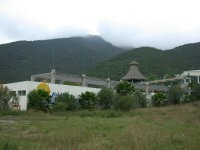
| 
|
| | | |
We were stuffed pretty much from munching all day while driving, so we all gathered in the Tuttles camper. Craig made popcorn and we brought deviled eggs. For dessert Craig broke into his supply of Snickers Bars, a seemingly bottomless magic bag on this trip. Add wine and we had a good time.
Mexican roads are the pitts. 300 miles is a good day. They are hard on vehicles. The Tuttles' camper started to self destruct. Here we are in the Tampico airport parking lot, rebuilding a car-top carrier support for the forward part over the cab. We spent the night there, as the great RV camping spot listed in our Mexico RV guide was bulldozed and being replaced by a housing development. The armed attendent at the parking lot assured us it was the safest place in the city to spend the night.
We occasionally encountered military checkpoints. They were looking for guns and drugs, and never hassled us much, despite our somewhat ragged appearance. They did get a chuckle out of the bullet holes Craig had in the side of his truck -- after they checked them out and discovered they were decals. They are a pretty good imitation.
The hardest part of our drive through Mexico was finding a place to spend the night where we felt safe. In every town we went through, people looked at us like we were from outer space. The RV books all say, "no problem, lots of places to spend the night." Maybe on the West coast, but we were traveling down the east coast.
George, the van, was getting pretty dirty, but Bill and I felt that was good; we would blend in a little, if that was possible. At one of the gas stations, the attendant wrote on the back, "No es polvo, es bronceador," -- "It's not dust, it's suntan lotion."
Bill and Carol had their bicycles strapped on the front of George; here's what much of Mexico looked like to us as we crawled south. Bill driving out of the picture on the left; Carol navigating out of the picture on the right; and me sitting in a captain's chair in the center, cracking nuts, slicing fruit and cheese and feeding them, or reading out loud.
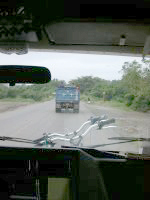
|
| |
Most roads in Mexico are shoulderless and drop off into a huge ditch, so we all figured it was close to suicide to drive at night. We saw one accident where two cars had gone off the road, and one of them had flipped.
We passed a nuclear power plant by the Gulf. The road was marked everywhere with an evacuation route. I can only imagine the frightening mess if everyone was trying frantically to evacuate by the narrow two lane roads.
We finally made it to the beach, at Chachalacca. We drove in late in the afternoon, looking for a place to camp. When we drove onto the beach, we drove out on a packed road in the sand, then started to turn around and promptly got stuck. The tide was coming in. We asked the locals if that part of the beach got under water. They said yes. We worked a little harder. It took about an hour and a lot of help from the locals to get unstuck. I was surprised at how easily George got stuck in the sand, since he's got dual wheels on the rear. But no four wheel drive, and we were loaded like a bloated whale.
I spent the night on a tarp between the vans, lying on the sand in my sleeping bag. Too warm, but tiny sand fleas were getting to me so I didn't want to stay on top. During the middle of the night the local dogs fought for hours chasing a bitch in heat around the beach. About 5 am someone lit off a big cherry bomb. Other than that it was a quiet night; I slept ok.
The next day we got an early start, as we had a lot of miles to make. All the literature says this stretch wasn't a good place to be stuck at night, so we were going for a record -- 450 miles. There were people doing a torch relay on the side of the road, at a spacing of about 100 yards per person. Running to celebrate Our Lady of Guadelupe. Their support vehicle would stop in the middle of the slow lane to pick people up and drop them off, instead of pulling onto the shoulder. It was an accident waiting to happen, but we never saw one.
We finally made it to Palenque, but not without some apprehension. George's engine started lugging. After a lot of discussion, we ended up cleaning the tank fuel filter. If you only know how to do a few things, you're somewhat limited in what you can repair. Fortunately, this was one of the few things we knew how to do, and it turned out to be the problem. We tried to check the filter in the carbureator, and even took off the engine hood inside the cab, but we still couldn't get at it. We gave up and tried things as they were. George puffed up a pretty steep hill just fine, so we crammed everything back together and called it good. Man, was it hot and noisy with the cover off the engine.
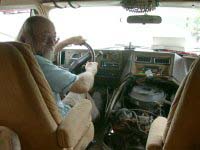
|
| |
As we neared Palenque, the terrain turned tropical and jungle-like. We camped at a place called "Mayabell" just outside the ruins. They have a nice inexpensive restaurant, a pool, and places for small RVs and tents. I slept on a tarp outside, as usual. It was great to wake up to the sound of birds and other critters. As you enter the town of Palenque, there is a wonderful sculpture of a Mayan head. Unfortunately, it was difficult to appreciate it with all the Christmas decorations overpopulating the area.
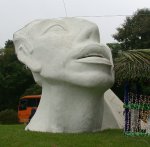
|
| |
We took a layover day in Palenque to see the ruins. Palenque is from the early Mayan period. The earliest evidence of occupation is about 100 b.c.; by the late classic period of Mayan culture, 600 to 900 a.d., Palenque was the power center for a large part of the present day Mexican states of Chiapas and Tabasco.
At the height of its power, Palenque was dominated by the Mayan king Pakal (Pacal), his wife (White Egret) and his son (Jaguar II) and grandson (Yellow Hornet).
Our guide to Palenque, Guijerrmo, was great.
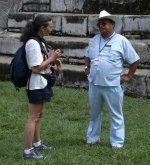
|
| |
Palenque had a big aqueduct for transporting water to the lower classes of workers who lived farther out, below the stone buldings.
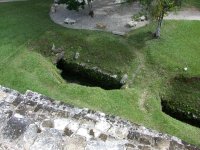
|
| |
The burial temple has a large tomb, painted red inside, which was where Pakal's mother was found. The palace pyramid / temple, has some nice inscriptions and and paintings and carvings on the walls. It also has nice straight sided "arches", really more of a trapezoidal hip roof type construction.
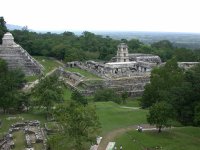
| 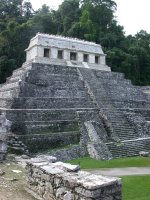
| 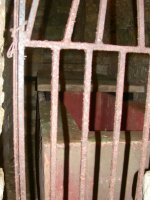
|
| | | |
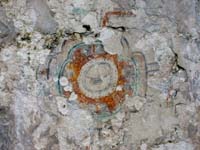
| 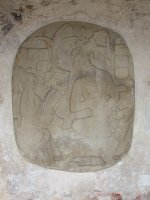
| 
| 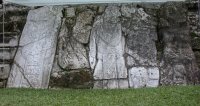
|
| | | | |
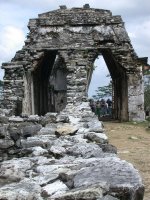
| 
|
| | |
The trail back from the temples followed a creek with gorgeous waterfalls, reminescent of Havasu in the Grand Canyon.
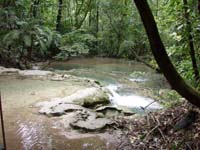
| 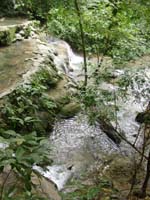
| 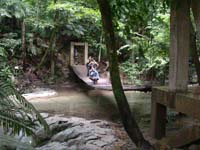
|
| | | |
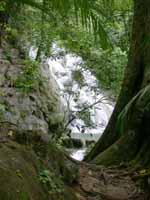
| 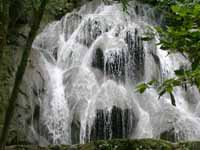
| 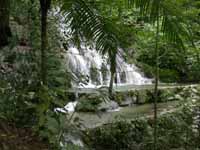
|
| |
The walk back through the jungle was wonderful. We got a chance to walk among the huge buttresses on the jungle trees, and found a wonderful spider.

| 
| 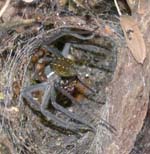
| 
|
| | |
From Palenque we worked our way down to Chetumal. The road seemed to be a bit unstable in places...
We got stopped several times at army check points where they were looking for arms and drugs. They were always polite, and in one case had a card in English explaining that they neded to search the vehicle.
We lost an avaccado somewhere along the way, so it's rolling around inside someplace, making guacamohle.
They clear the roadsides by hand -- you see men with machettes everywhere, slowly swinging away at the tall grass. I thought about using a tractor and a brush hog the way they do at home, but it would be tough -- there isn't room to drive on the shoulder very far before you'd end up over the side, rolled off the steep embankment.
At long last we made it to Chetumal, the bottom of the Yucatan peninsula. We arrived to sunshine and the smell of the Bay. We drove down to the waterfront, where there is a nice clean park, and parked under some trees along the side of the road. The Chetumal Yacht Club pier was nearby, with the public pier beyond.
We walked around town, taking in he sights and looking for groceries, but finding mostly clothing, shoe, and appliance stores. When we got back from wandering around town, we discovered the co-pilot's vent window was shattered. Glass all over the seat, but fortunately, nothing missing. I guess someone must have scared the guy off. When Bill and Carol talked to some policemen about it, they didn't seem too concerned. Apparently we were stupid to park it where we did. They said to park on the main street, where there were lots of people.
So now we couldn't lock the RV. We checked all over town, even the Chevy dealer. He told us they didn't even have a book for the van, so they couldn't order parts. Noone seemed to think they could even cut us a piece of glass or plastic to fit. I was floored. Bill and I tried to find a piece so we could make it ourselves, but I guess our Spanish wasn't good enough, or we weren't desparate enough yet.
We gave up, and drove out to the east of town to camp for the night at a nice place that actually catered to RVs. We had an evening snack outside, and the caretaker brought a torch down to the beach for us. We were exhausted from our van window ordeal, and didn't even bother with dinner. We just snacked on smoked salmon and cheese and crackers.
The next day I noticed Frigate Birds flying around, so I was starting to feel like I was in the Caribbean again.